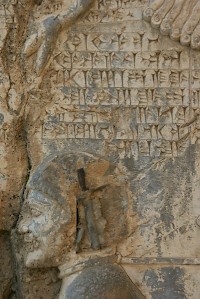Nidintu-Bêl
Nidintu-Bêl (Old Persian Naditabira) was the son of a Babylonian official named Kîn-Zêr; Nidintu-Bêl himself was a man of some importance too.

Babylon, once the capital of an important empire, had been part of the Achaemenid empire since 539 BCE, but the quietness of the Persian rule had been disturbed in 522, when a Magian named Gaumâta had seized the throne and was killed by the Persian prince Darius, who became king on 29 September
Immediately after this counter-coup, Nidintu-Bêl proclaimed himself king of an autonomous Babylonia. According to the Behistun inscription, he claimed to be the son of Nabonidus, the last king before Babylonia lost its independence, and called himself Nebuchadnezzar III. His 'first regnal year' is mentioned in a cuneiform letter from 3 October 522 BCE, and it may well have been written on the day of his inauguration.
Immediately, Darius advanced against the rebel. The Babylonians were unable to prevent the Persians from crossing the Tigris, and on 13 December, their army was defeated. Five days later, a second battle took place near Zâzâna on the Euphrates; again, Darius' army was victorious. Nidintu-Bêl was killed when Darius took Babylon. (The Greek researcher Herodotus [c.480-c.429] connects the siege of Babylon with the story of Zopyrus.{{Herodotus, Histories 3.150-160.)
This was not the end of the rebellious feelings. When Darius was in Media to wage war upon the rebel king Phraortes, a second rebellion took place in Babylonia, led by Arakha, whose throne name was Nebuchadnezzar IV. Darius' general Intaphrenes took care of it in 521.
The Behistun inscription is the most important source on these events. Unfortunately, this text is biased. There are several letters from Babylonia which mention Nidintu-Bêl, but they contain almost no useful information. The text of the Behistun inscription is also damaged: the name of the usurper's father can only be reconstructed from the Babylonian translation. The name 'Aniri' that is sometimes read, is based on the damaged Persian text and incorrect.
Almost two hundred years later, probably in 336/335, a Babylonian usurper called himself Nidin-Bêl - thus honoring Nebuchadnezzar III.
The picture shows Nidintu-Bêl at the Behistun relief.